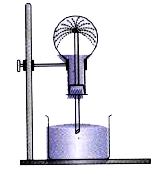Name two gases which can be used in the study of the fountain experiment. State the common property demonstrated by the fountain experiment.
Step-by-Step Solution:
1. Identify the Gases Used in the Fountain Experiment:
- The Fountain experiment can utilize various gases, but two common gases used are:
- Ammonia (NH₃)
- Hydrogen Chloride (HCl)
2. Explain the Fountain Experiment:
- In the Fountain experiment, a flask containing one of the gases (like ammonia or hydrogen chloride) is set up. When a few drops of water are injected into the flask, the gas begins to dissolve in the water.
3. Observe the Effect of Dissolving Gas:
- As the gas dissolves in the water, it creates a decrease in pressure inside the flask. This pressure change causes water to be drawn up from a connected beaker into the flask.
4. Demonstrate the Common Property:
- The common property demonstrated by the Fountain experiment is the solubility of gases in water. The experiment shows how different gases can dissolve in water and the effect this has on pressure and movement of liquids.
5. Summarize the Findings:
- Therefore, the two gases that can be used in the Fountain experiment are ammonia and hydrogen chloride, and the common property demonstrated is the solubility of gases in water.
---
- The Fountain experiment can utilize various gases, but two common gases used are:
- Ammonia (NH₃)
- Hydrogen Chloride (HCl)
- In the Fountain experiment, a flask containing one of the gases (like ammonia or hydrogen chloride) is set up. When a few drops of water are injected into the flask, the gas begins to dissolve in the water.
- As the gas dissolves in the water, it creates a decrease in pressure inside the flask. This pressure change causes water to be drawn up from a connected beaker into the flask.
- The common property demonstrated by the Fountain experiment is the solubility of gases in water. The experiment shows how different gases can dissolve in water and the effect this has on pressure and movement of liquids.
- Therefore, the two gases that can be used in the Fountain experiment are ammonia and hydrogen chloride, and the common property demonstrated is the solubility of gases in water.
Topper's Solved these Questions
- STUDY OF COMPOUNDS - HYDROGEN CHLORIDEBOOK - ICSECHAPTER - STUDY OF COMPOUNDS - HYDROGEN CHLORIDEEXERCISE - ADDITIONAL QUESTIONS
27 Videos
- STUDY OF COMPOUNDS - HYDROGEN CHLORIDEBOOK - ICSECHAPTER - STUDY OF COMPOUNDS - HYDROGEN CHLORIDEEXERCISE - UNIT TEST PAPER 7A - HYDROGEN CHLORIDE
28 Videos
- STUDY OF COMPOUNDS - HYDROGEN CHLORIDEBOOK - ICSECHAPTER - STUDY OF COMPOUNDS - HYDROGEN CHLORIDEEXERCISE - UNIT TEST PAPER 7A - HYDROGEN CHLORIDE
28 Videos
- STUDY OF COMPOUNDS - AMMONIA BOOK - ICSECHAPTER - STUDY OF COMPOUNDS - AMMONIA EXERCISE - UNIT TEST PAPER 7B - AMMONIA
22 Videos
- STUDY OF COMPOUNDS - NITRIC ACID BOOK - ICSECHAPTER - STUDY OF COMPOUNDS - NITRIC ACID EXERCISE - UNIT TEST PAPER 7 C - NITRIC ACID
27 Videos
Similar Questions
Knowledge Check
In the Fountain experiment with ammonia, the colour of the fountain is
ARedBBlueCPinkDDark green
Name two poisonous gases which can be prepared from chlorine gas.
View SolutionName two poisonous gases which can be prepared from chlorine gas.
View SolutionMention the main conclusions derived from the Fountain experiment with ammonia.
View SolutionWhich property of hydrogen chloride is demonstrated by this experiment?

View SolutionState what the fountain experiment demonstrates with reference to HCl gas.
View SolutionName the experiment and state its procedure to demonstrate the high solubility of ammonia.
View SolutionThe diagram shows a simple arrangement of the fountain experiment:
Name the two gases you have studied which can be used in this experiment.

View Solution


